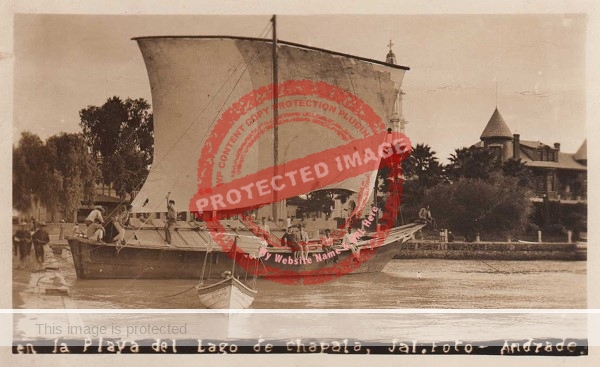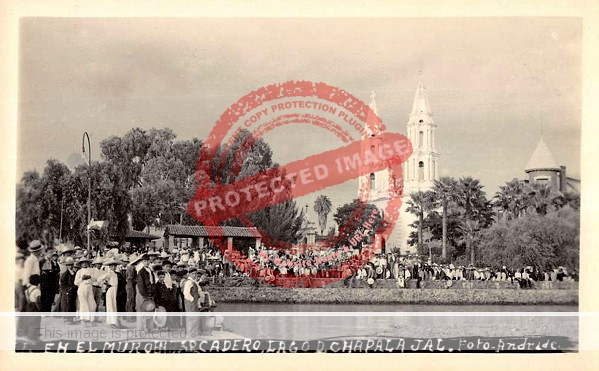Every now and again my research into the photographers who captured images of Lake Chapala used on vintage postcards draws a near-complete blank. This post considers two striking images taken by “Andrade.”
The only reference I have so far found to Andrade comes in the unpublished journal (now in the archives of the California Historical Society) kept by Dr Leo Stanley, a prison doctor from California, when he visited Guadalajara and Lake Chapala in 1937. Near the end of his trip, Stanley decided to take a boat from Chapala to Mezcala Island to see for himself the ruins of the nineteenth century jail that had given rise to the island’s nickname, Prison Island. Just as Stanley is setting sail, Andrade asks if he can join him:
15 October 1937: I engaged the launch “Corona” to take us to the island, and invited Ysidoro [Ysidoro Pulido] and the two little Mexican boys of the day before to go with us. As we were about ready to shove off, a Mexican came to me and asked how much I would charge to let him go along with us to the island. He said he was a photographer and wanted to take some pictures there. I told him there would be no charge, and asked him to come along. He said his name was Andrade, and that he had taken a number of pictures about the lake, some of which he showed to me. With him was another boy of about fourteen years of age. This lad carried on his back a large gourd with a hinged door. In this gourd, he carried some of his photographic supplies.”
Unfortunately, no additional biographical information about Andrade is currently known. His two known postcards of Lake Chapala, presumed to date from the 1930s, are both views from the pier in Chapala looking towards the Widow’s Bar, Parroquía de San Francisco (the main church in Chapala) and the Casa Braniff. (For details about these buildings, see If Walls Could Talk: Chapala’s Historic Buildings and Their Former Occupants, also available in Spanish as Si las paredes hablaran: Edificios históricos de Chapala y sus antiguos ocupantes.)

Andrade. c 1935. En la playa del lago de Chapala.
The first image (above) reminds us that during the nineteenth and early twentieth centuries, the lake was a vital link in the regional transportation network connecting central Mexico to Guadalajara. Local craft crisscrossed the lake every day ferrying all manner of goods and provisions, as well as people, from one small port to the next.
The vessels in use included paddle steamers, fishing skiffs, flat-bottomed launches (canoas) and large sail canoes (canoas de vela), like the one shown in the photograph. Paddle steamers (vapores) were faster, and could carry more cargo, but required more investment and were more expensive to operate than sail canoes.
Almost every village, however small, had its own pier or jetty. Larger towns, like Chapala, had several small piers, some for public use, others built privately by local property owners. The largest piers, like the one in the photograph offered sufficient depth of water that even large cargo-carrying vessels could safely tie up to load and unload.

Andrade. c 1935. En el muro, embarcadero. Lago de Chapala.
The second postcard photograph is more unusual. The large throng of people occupying the pier and lakeshore wall must presumably have been for some very special occasion or event. But what is the occasion? There are no obvious clues on the image. If you can suggest a reason or occasion for this large crowd to gather by the pier, please get in touch!
My 2022 book Lake Chapala: A Postcard History uses reproductions of more than 150 vintage postcards to tell the incredible story of how Lake Chapala became an international tourist and retirement center.
Acknowledgments
My heartfelt thanks to Frances Kaplan, Reference & Outreach Librarian of the California Historical Society, for supplying photos of Stanley’s account of his time at Lake Chapala. I am very grateful to Ms Kaplan and the California Historical Society for permission to reproduce the excerpt used in this post.
Source
- Leo L. Stanley. “Mixing in Mexico”, 1937, two volumes. Leo L. Stanley Papers, MS 2061, California Historical Society. Volume 2.
Comments, corrections and additional material are welcome, whether via the comments feature or email.
Tony Burton’s books include “Lake Chapala: A Postcard History” (2022), “Foreign Footprints in Ajijic” (2022), “If Walls Could Talk: Chapala’s historic buildings and their former occupants” (2020), (available in translation as “Si Las Paredes Hablaran”), “Mexican Kaleidoscope” (2016), and “Lake Chapala Through the Ages” (2008).
Hi Tony,
Just a thought but I don’t really know if it’s too unfounded.
In Gloucester, Massachusetts there was an annual Blessing Of The Fleet which were fishing boats pretty much owned by Portuguese and Italian people who were Catholics. My father and mother would drive us children, ( 3 ), up the North Shore about 40 miles to witness the occasion. I think it was low key, confined to the harbor and there were many onlookers. Perhaps that is what was happening in that scene that the photo captured. Looks like the boats have not come into the dock area yet.
Best wishes,
Michael
Hi Michael, Always good to hear from you. The scene is certainly some very major event but the curious thing (from my perspective) is that there are only a handful of pre-1980 images showing such a large throng of people, whether on the pier or witnessing some event in one of the local towns. Chapala does have an annual “Navy Day” celebration but it has never drawn anywhere near that number of onlookers. We might have more clues if we knew more about Andrade and could narrow down the date, but so far, I’ve had no luck in that regard. Best wishes, Tony.
Hope you can find more on this person and more of his photographs. I want to offer an idea on the second photo with the crowd–and also perhaps relate one drawback on my guess–anyway in 1972 Tapachula–huge crowds would gather when the train arrived—my first thought was they are waiting for a steamboat, barge or something bring goods/mail or whatever–but interestingly– in the foreground it appears one or more people are staring at the photographer– loved the photos–thanks
Hi Bill, Thanks for the suggestion. I agree that the crowd appears to be waiting for something, but steamships were, as you know, well on their way out by the time of the photo. I suspect it might have been an event of religious significance, given that similar-sized crowds now gather to watch the arrival of the Virgin of Zapopan to bless the lake, but (so far as I know) that tradition did not begin until the early 1950s when the lake level fell so precipitously that you could almost walk to the islands. Best, Tony.